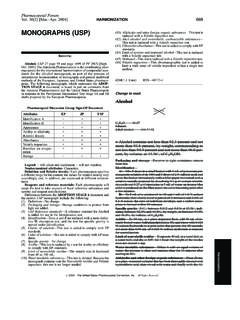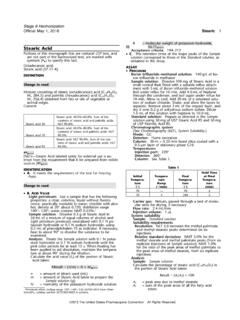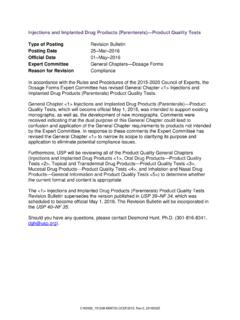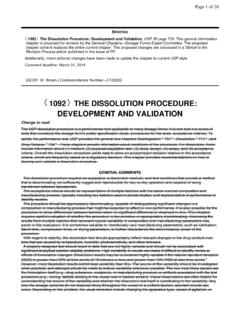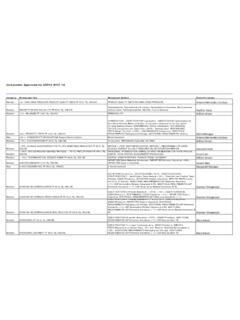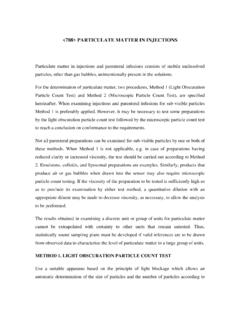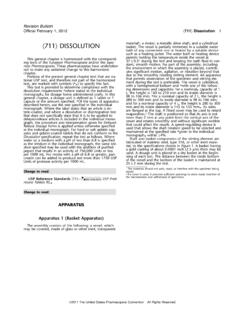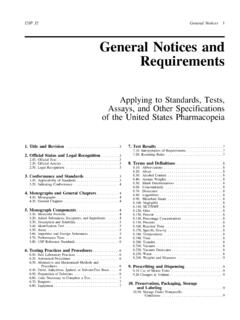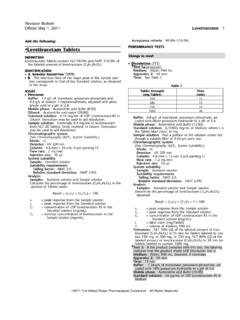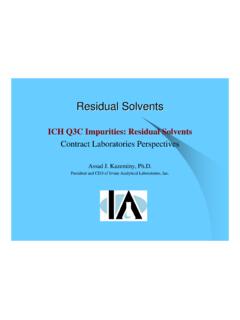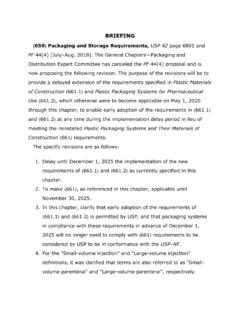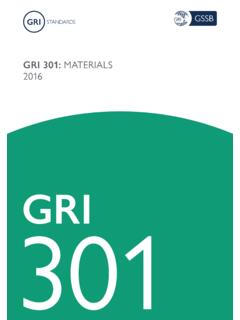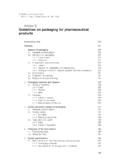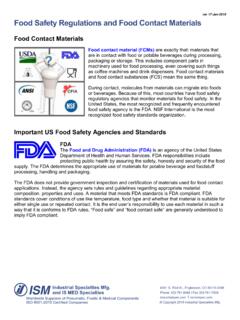Transcription of <661> Plastic Packaging Systems and Their Materials of ...
1 <661> Plastic Packaging Systems and Their Materials of construction Type of Posting Revision Bulletin, Postponement Posting Date 28 Apr 2017, revised 26-May-20171 Official Date 01 May 2017 Expert Committee General Chapters Packaging and Distribution Reason for Revision Compliance In accordance with the Rules and Procedures of the 2015-2020 Council of Experts, the General Chapters Packaging and Distribution Expert Committee has revised General Chapter <661> Plastic Packaging Systems and Their Materials of construction . The purpose of the revisions will be to provide a three-year period for implementation of the requirements specified in General Chapters < > and < >, which otherwise will become applicable on May 1, 2017 through General Chapter <659>; to reinstate requirements previously expressed in General Chapter <661> during this three-year period; to enable early adoption of the requirements in General Chapters < > and < > at any time during the three-year period in lieu of meeting the reinstated <661> requirements; and to remove the exemption to General Chapters < > and < > for previously approved Plastic Materials and Packaging Systems .
2 The specific revisions are as follows: Delay until May 1, 2020 the implementation of new requirements of General Chapters < > and < > as currently specified in General Chapter <659>. Incorporate into General Chapter <661> the requirements previously specified in the USP 38 NF 33 version of General Chapter <661>. Reference General Chapter <661> in General Chapter <659> to make these previous requirements applicable until May 1, 2020. Clarify in General Chapter <659> that early adoption of the requirements of < > and < > is permitted by USP, and that Packaging Systems in compliance with these requirements in advance of May 1, 2020 will no longer need to comply with the reinstated <661> requirements to be considered by USP to be in conformance with the USP NF. Remove the current exemption to General Chapters < > and < > for Plastic Materials and Packaging Systems previously approved by a regulatory authority.
3 The <661> Plastic Packaging Systems and Their Materials of construction Revision Bulletin will supersede the monograph becoming official in USP 40 NF 35. The Revision Bulletin will be incorporated in USP 41 NF 36. Should you have any questions, please contact Desmond Hunt, (301-816-8341 or 1 The text of the notice was revised May 17, 2017 to clarify that the exemption is being removed from both chapters < > and < > C188588-M99420-GCPD2015, Rev. 1 20170526 661 Plastic Packaging Systems AND Their Materials OFCONSTRUCTIONAdd the following:(If the option of early adoption of Plastic Materials of construction and Plastic Packaging Systems for Pharmaceuti-cal Use is not used prior to May 1, 2020, the requirements under this chapter will apply.)(RB 1-May-2017)Add the following:INTRODUCTIONIt is the purpose of this chapter to provide standards for Plastic Materials and components used to package medical articles(pharmaceuticals, biologics, dietary supplements, and devices).)
4 Definitions that apply to this chapter are provided in Packagingand Storage Requirements 659 . Standards and tests for the functional properties of containers and Their components are pro-vided in Containers Performance Testing 671 .In addition to the standards provided herein, the ingredients added to the polymers, and those used in the fabrication of thecontainers, must conform to the requirements in the applicable sections of the Code of Federal Regulations, Title 21, IndirectFood Additives, or have been evaluated by the FDA and determined to be acceptable substances for the listed articles are identified and characterized by IR spectroscopy and differential scanning calorimetry. Standards are provi-ded in this chapter for the identification and characterization of the different types of Plastic , and the test procedures are provi-ded at the end of the chapter. The degree of testing is based on whether or not the container has direct contact with the drugproduct, and the risk is based on the route of are composed of a mixture of homologous polymers, having a range of molecular weights.
5 Plastics may contain oth-er substances such as residues from the polymerization process, plasticizers, stabilizers, antioxidants, pigments, and Materials meet the requirements for food contact as provided in the Code of Federal Regulations, Title 21. Factors such asplastic composition, processing and cleaning procedures, surface treatment, contacting media, inks, adhesives, absorption andpermeability of preservatives, and conditions of storage may also affect the suitability of a Plastic for a specific use. Extractiontests are designed to characterize the extracted components and identify possible migrants. The degree or extent of testing forextractables of the component is dependent on the intended use and the degree of risk to adversely impact the efficacy of thecompendial article (drug, biologic, dietary supplement, or device). Resin-specific extraction tests are provided in this chapterfor polyethylene, polypropylene, polyethylene terephthalate, and polyethylene terephthalate G.
6 Test all other plastics as direc-ted for Test Methods, Physicochemical Tests. Conduct the Buffering Capacity test only when the containers are intended to holda liquid components used for products of high risk, such as those intended for inhalation, parenteral preparation, and oph-thalmics, are tested using Test Methods, Biological containers intended for Packaging products prepared for parenteral use meet the requirements for Test Methods, Bio-logical Tests and Physicochemical Tests. Standards are also provided for polyethylene containers used to package dry oral dos-age forms that are not meant for constitution into CONTAINERSS copeThe standards and tests provided in this section characterize containers and components, produced from either low-densitypolyethylene or high-density polyethylene of either homopolymer or copolymer resins that are interchangeably suitable forpackaging dry oral dosage forms not meant for constitution into solution.
7 All polyethylene components are subject to testingby IR spectroscopy and differential scanning calorimetry. Where stability studies have been performed to establish the expira-tion date of a particular dosage form in the appropriate polyethylene container, then any other polyethylene container meet-ing these requirements may be similarly used to package such a dosage form, provided that the appropriate stability programsare expanded to include the alternative container, in order to ensure that the identity, strength, quality, and purity of the dos-age form are maintained throughout the expiration and low-density polyethylene are long-chain polymers synthesized under controlled conditions of heat andpressure, with the aid of catalysts from not less than ethylene and not less than total olefins. Other olefin ingre-dients that are most frequently used are butene, hexene, and propylene. High-density polyethylene and low-density polyethy-Revision BulletinOfficial May 1, 2017 661 1 2017 The United States Pharmacopeial Convention All Rights , Rev.
8 1 20170526lene both have an IR absorption spectrum that is distinctive for polyethylene, and each possesses characteristic thermal proper-ties. High-density polyethylene has a density between and g per cm3. Low-density polyethylene has a density be-tween and g per cm3. Other properties that may affect the suitability of polyethylene include modulus of elastici-ty, melt index, environmental stress crack resistance, and degree of crystallinity after PolyethyleneInfrared Spectroscopy Proceed as directed for Test Methods, Multiple Internal Reflectance. The corrected spectrum of thespecimen exhibits major absorption bands only at the same wavelengths as the spectrum of USP High-Density Scanning Calorimetry Proceed as directed for Test Methods, Thermal Analysis. The thermogram of the speci-men is similar to the thermogram of USP High-Density Polyethylene RS, similarly determined, and the temperature of the en-dotherm (melt) in the thermogram of the specimen does not differ from that of the USP Reference Standard by more.
9 Heavy Metals and Nonvolatile Residue Prepare extracts of specimens for these tests as directed for Test Methods, Physi-cochemical Tests, except that for each mL of Extracting Medium the portion shall be 60 cm2, regardless of METALS Containers meet the requirements for Test Methods, Physicochemical Tests, Heavy RESIDUE Proceed as directed for Test Methods, Physicochemical Tests, Nonvolatile Residue, except that the Blankshall be the same solvent used in each of the following test conditions: the difference between the amounts obtained from theSample Preparation and the Blank does not exceed mg when water maintained at a temperature of 70 is used as theExtracting Medium; does not exceed mg when alcohol maintained at a temperature of 70 is used as the Extracting Medi-um; and does not exceed mg when hexanes maintained at a temperature of 50 is used as the Extracting Used in Contact with Oral Liquids Proceed as directed for Test Methods, Physicochemical Tests, PolyethyleneInfrared Spectroscopy Proceed as directed for Test Methods, Multiple Internal Reflectance.
10 The corrected spectrum of thespecimen exhibits major absorption bands only at the same wavelengths as the spectrum of USP Low-Density Polyethylene Scanning Calorimetry Proceed as directed for Test Methods, Thermal Analysis. The thermogram of the speci-men is similar to the thermogram of USP Low-Density Polyethylene RS, similarly determined, and the temperature of the endo-therm (melt) in the thermogram of the specimen does not differ from that of the USP Reference Standard by more than .Heavy Metals and Nonvolatile Residue Prepare extracts of specimens for these tests as directed for Test Methods, Physi-cochemical Tests, Testing Parameters, Sample Preparation, except that for each mL of Extracting Medium the portion shall be60 cm2, regardless of METALS Containers meet the requirements for Test Methods, Physicochemical Tests, Heavy RESIDUE Proceed as directed for Test Methods, Physicochemical Tests, Nonvolatile Residue, except that the Blankshall be the same solvent used in each of the following test conditions: the difference between the amounts obtained from theSample Preparation and the Blank does not exceed mg when water maintained at a temperature of 70 is used as theExtracting Medium; does not exceed mg when alcohol maintained at a temperature of 70 is used as the Extracting Medi-um.
